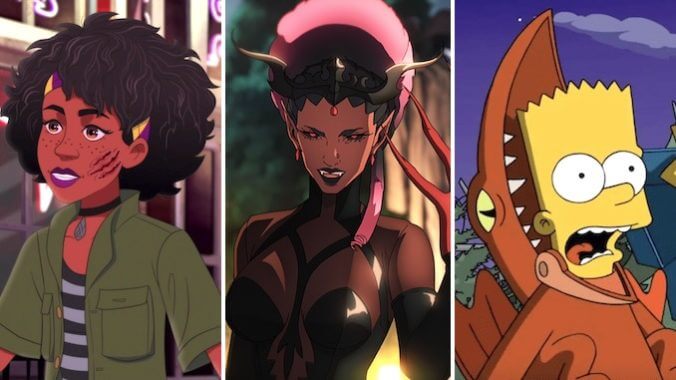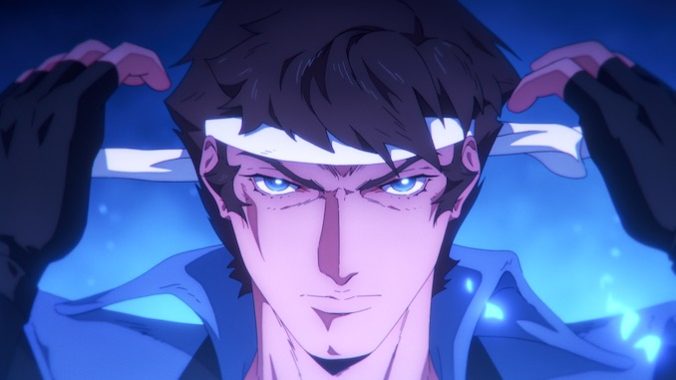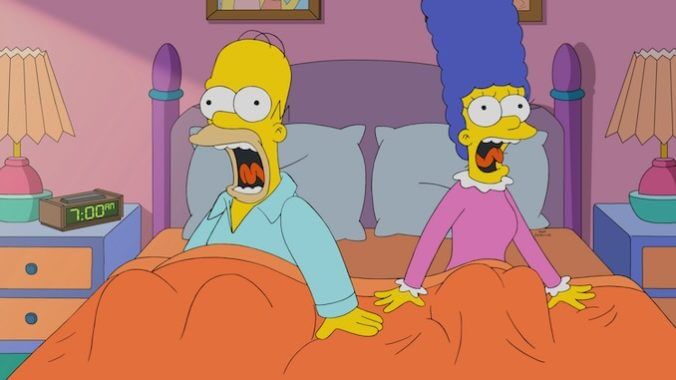Toon In: Animated TV Highlights for October 2023, from the Castlevania: Nocturne Finale to Treehouse of Horror XXXIV
Photo Courtesy of ABC
Welcome to the ink, paint, and pixel corner of Paste TV, where we’re highlighting some of the best premium animation projects on streaming or direct-to-video aimed for teens and adults. This monthly column not only provides an overview of the new animated series to check out, but we’ve also collected some of the finest creators and voice talents in the medium to give updates, or introductions, to their series.

Teenage Euthanasia – Season Finale Post Mortem (Aired September 28)
All of the animated shows on Adult Swim are odd, but that makes this network such a special playground of series that embrace non-conformity and abstract animation design. Case in point, Alyson Levy and Alissa Nutting’s white trash comedy, Teenage Euthanasia, which just ended its second season of zombie hijinks performed by the most-Florida of characters, Trophy Fantasy (Maria Bamford).
“Our only limitations we could possibly have are just ourselves,” Levy tells Paste about the bonkers places they go in any given episode. “We try to really push every single story, episode, character, and design to challenge ourselves and make ourselves laugh… or just creep each other out, whichever feels right for that day. The voice of the show is unique, and we try to protect that.”
If you haven’t caught Teenage Euthanasia, its high concept premise centers on “Annie” Fantasy (Jo Firestone), an insecure teen brought up by her grandma Baba (Bebe Neuwirth) and her Uncle Pete (Tim Robinson) in their family-run funeral home, Tender Endings in Fort Gator, Florida. Annie is reunited with the corpse of her narcissist mom, Trophy, in a bizarre revival that brings the family together under one roof.
The rare animated comedy written by women with a woman-centric story, Nutting says they don’t take that for granted. “We really like to write for the teens who are in therapy, or the teens who are lonely, left out or feel like no one gets them and they don’t have a place in the world,” she says. “Annie, our protagonist, has a lot of those qualities at different times. And it’s nice to have a core cast in a show that’s not only three generations of women, but they’re also three generations of women who are all outsiders. They all differ from what we’re told to be as women, both in their generation and also throughout all of time.”
Levy continues, “And while it’s a show that’s really absurd and really crazy, it is also real and about real stuff. Between the characters, there is real emotion and real caring on some level. That interested us, so we’re not just like a joke machine. We are, but there are things we felt like we wanted to talk about in being a mother, being a daughter, and just being a woman.”
The second season finale, “A Very Fantasy Vacation,” ended on an epic road trip that took the Fantasy family out of Florida for the first time, and essentially pulled a Bugs Bunny by forcibly separating the state from the continent. Levy says they wanted to go big just to see how far they could push the boundaries of their own show.
And Nutting says Florida being relentlessly ribbed by the show is done with a lot of love. “Florida is this magical place where it’s sort of all out in the open and even celebrated in some ways of just being the proud train wreck of the United States,” she says with sincerity. “It allows for a lot of social commentary, and I think in a lot of ways, it’s discounted, forgotten, and seen as too tacky for the rest of society, which is exactly how this family and all our characters are seen. The nesting doll of metaphors is so rich.”
As for their finale, it ends on a big twist that implies the series is a fanciful story that’s being told by a gator dad to his gator kids. Done in a more Disney style of animation, Levy says that the whole scene came very late in the episode’s planning. “It came during the animatic, where it just felt like it needed an extra button on it,” she explains. “I think for us, it’s just an acknowledgement of the storytelling of this show. And one of the little alligators is Alissa’s daughters.”
The team is currently in negotiations to make a third season, so they hope people will watch the show on Max and tell their friends. And they thank everyone who watches it live, which makes a big difference. “We have a lot of ideas and ones that we didn’t get to do,” Levy says. “For us, the show goes on forever. I feel like we’ve just barely scratched the surface because the more you know the characters, the funnier and better the show gets.”
Castlevania: Nocturne – Season Finale Post Mortem (Aired September 28)

Castlevania: Nocturne is the latest installment in Netflix’s adaptation of Konami’s Castlevania videogame series into an expanded animation mythology. All eight episodes dropped September 28th, and it has already been renewed for a second season. Nocturne deeply expanded the characters and world of the vampire-killing Belmont family. It’s set during the French Revolution and centers on the vengeance seeking Richter Belmont (Edward Bluemel).
Nocturne is written by Clive Bradley with producer Kevin Kolde serving as co-showrunner. Kolde tells Paste that they decided on Richter as the primary character, and then built the season around him. “Richter and his story, and the time period, which is from the games, came before we settled on this particular story,” he says. “We’re always trying to stick to the heart of what’s come before and what it means to be a Belmont, and what that legacy is in terms of the character. Richter obviously is a very different character than Trevor was,” he says referring to the protagonist of Castlevania. “His life story is different. But the show is very grounded and the characters are very real.”
Co-director Sam Deets says the setting of the series also adds a lot of dimension to this series. “There’s a lot of talk about revolution this season,” he says of the theme that is the through-line. “Clive is a history nerd and he really was wanting to build around that, and build a cast of characters that supported that.”
Fellow co-director Adam Deets adds, “One of the big things that is super interesting and very unique is covering the Haitian Revolution. That is a piece of history that was integral to the French Revolution that is never talked about or touched on. And it isn’t just tacked on. It’s a thing that matters. Stuff like that brings a level of interest that I think is special. And I’m glad that we did it.”
When asked if they had a favorite moment to create this season, Sam says the moment that Richter gets his magic. “It was difficult and very important to land,” he says. “But at the same time, when I was storyboarding it, and then planning out all of the animators and artists to work on it, that all flowed really, really nicely.”
For Adam, it was the eighth episode. “All the stuff with the hell machine getting picked up off the ground and slammed back down with pipes dripping off it was a unique challenge for us,” he explains, because 3D animation is not typically used by the studio. “We use it in very minimalistic ways. So trying to find ways to make that stuff work, on top of all the crowd battle was wild and very difficult. But I’m really proud of the team for what we were able to do.”
And then there’s Alucard (James Callis) showing up in the final seconds of the season finale. Kolde says that was always the planned ending point when they blocked out the right episodes of the season.
“What’s funny is I think that I boarded the little part with Alucard showing up in like two hours,” Sam shares. “It was basically the quickest, ugliest scribbles at the tail end of pre-production. But then after we finished up, there was this nice period where I moved on to animation direction and I got to go in and do all the layouts for everything and make it all pretty. But the whole ending sequence, aside from a handful of shots, was held very close to the chest. I held on to a bunch of the key shots for myself, and handpicked the animators and did corrections myself because the moment had to be perfect.”
Fright Krewe (October 2)

Just in time for the Halloween season, DreamWorks Animation’s Fright Krewe Season 1 is a teen-centric, supernatural mystery series that is set within the contemporary Voodoo culture of New Orleans. Created by horror director Eli Roth and author James Frey, the series itself was developed and showrun by Kipo and the Age of Wonderbeasts writers Joanna Lewis and Kristine Songco. Featuring an ensemble of local teens who are bound together first by a shared detention, and then by getting imbued by individual Voodoo spirits so they can fight an evil awakened spirit, think of this as an animated The Breakfast Club meets The Monster Squad.
Inspired by the city of New Orleans, Roth and Frey set their original series premise right in the heart of the French Quarter, which thrilled Lewis and Songco. While the pair had never written in the horror genre before, they were drawn more deeply into every discussion they had with Roth and Frey and eventually felt it was a “meant to be” project. “Even though we were a little bit like, ‘How are we going to handle horror?’ We were way too interested to say no,” Lewis tells Paste.
Lewis says the show is very much a “love letter” to the incredibly rich city. “It was really important to us to make sure that we were being very authentic,” she says. “And this is basically about ghost stories, legends and monster stories, so New Orleans was the perfect place to set it.”
The gorgeously animated series incorporates the architecture of the French Quarter, the flora and fauna of the bayou, as well as the color palette of the city and infuses it within the series. Much of the action takes place at night, so there are a lot of jump scares and no holds barred-creatures portrayed too.
“Shane Acker (9) and Peter Markowski were hugely influential in creating the look and the feel of the show,” Lewis says. “We expressed how much we wanted it to be authentic, and to be really heavily inspired by New Orleans. Both of them ran with that, so some of the designs are out-of-control stunning.”
Animated in traditional 2D style, Songco says that was a battle won because of the flexibility that it offered a series like this with an already large ensemble of five core teens, and many support characters of the human and demon derivations. “CG is doable, but you have to really, really think about how many characters you have,” Songco explains. “And even a damaged set counts as a set, even a costume change counts as a character. Plus, the architecture of New Orleans is just so gorgeous and there’s just a lot more detail in making it look old and stuff like that, that is a little bit easier to pull off [in 2D].”
-

-

-

-

-

-

-

-

-

-

-

-

-

-

-

-

-

-

-

-

-

-

-

-

-

-

-

-

-

-

-

-

-

-

-

-

-

-

-

-









































